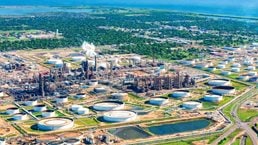Clean hydrogen is critical in the global journey to a net-zero energy system—and Houston is being recognized as a possible epicenter of a global clean-hydrogen hub. A 2022 report from the Center for Houston’s Future discussed a long-term supply and demand plan for clean hydrogen in the US Gulf Coast (USGC) and offered key enablers to achieve this goal.1
In Texas alone, clean hydrogen demand could reach 21 million tons per annum (MTPA), which potentially could reduce global CO2 by 220 million tons (MT) by 2050. And the impact extends beyond net-zero goals—30 to 60 percent of the projects could be located in communities that would be most impacted, creating approximately 180,000 direct, indirect, and induced jobs. The effect would be significant: a clean-hydrogen hub could possibly generate around $100 billion in additional GDP by 2050 for Texas.
Recent global developments have accelerated the necessity for clean hydrogen. COP27 highlighted the need for the world to move toward net zero to limit global warming from exceeding 1.5°C.2 The energy crisis, fueled by the COVID-19 pandemic and the invasion of Ukraine, has accelerated the energy transition as multiple net-importing energy countries seek energy security—chiefly from clean energy.3
A boost for clean hydrogen will come from the 2021 US Bipartisan Infrastructure Law, as well as from the US Inflation Reduction Act of 2022 (IRA), which will favor hydrogen-production economics in unprecedented ways by setting forth highly impactful provisions to develop and scale climate-friendly technology.4
In late 2022, HyVelocity Hub—comprising industry, universities, and leading energy companies and organizations that work to advance the clean-hydrogen ecosystem in Texas, Southwest Louisiana, and along the USGC—received a notice of encouragement from the US Department of Energy. This notice indicated that HyVelocity has the potential to be chosen as a regional clean-hydrogen hub as outlined in the Bipartisan Infrastructure Law.5
However, much of this planning is for long-term development. This article instead focuses on the “here and now” for clean hydrogen—the next three to five years. What can the USGC do in the near term to jump-start the clean-hydrogen economy? Creating demand in four key sectors, leveraging the IRA, and taking a consortium approach could be a good start.
Four focus areas for clean-hydrogen adoption
Demand creation in key sectors will be pivotal to jump-starting the clean-hydrogen economy in the region. Four demand areas have been prioritized—ammonia, petrochemicals and refining, ground transportation, and power and utilities—based on their potential market size, strategic fit with the region’s economy and endowment, demand signals, and the likelihood of clean hydrogen being “in the money” (Exhibit 1).

Ammonia for domestic use and exports
Clean ammonia could be one of the most economically favorable sectors for clean-hydrogen uptake and has significant export potential due to foreign governments’ decarbonization initiatives and clean power sourcing. By 2030, ammonia demand for domestic use and exports could reach 3 MTPA.6
The USGC’s resources and location position it to be a global competitor in blue and green ammonia production. Blue and green ammonia production costs could be competitive for exports compared with international peers due to gas, solar, and wind resources in the area. Blue ammonia may be more attractive than green for importing countries, prioritizing price over carbon-intensity level, while clean ammonia may replace grey ammonia in fertilizers as agricultural sectors move toward decarbonization.
Petrochemicals and refining
Texas is the largest oil-producing state in the United States and home to crucial players who have pledged to net zero.7 Hydrogen could be one of the crucial levers to decarbonize operations and support players to achieve their net-zero goals.
Hydrogen is a critical feedstock for many manufacturing processes in refining and petrochemical production, an industry with an expansive footprint across the USGC. It could also be used in “fuel switching” to replace natural gas for heating in refineries and petrochemical plants. Refineries could consider a hub-scale, clean-hydrogen approach for fuel-switch use cases and for their hydrotreating and hydrocracking processes.
Considering hydrogen’s role as a feedstock, we estimate potential demand for clean hydrogen of approximately 2 MTPA by 2030. If fuel switching from natural gas to clean hydrogen for heating takes off, more than 1 MTPA could be unlocked.
Further, optimizing hub-scale production and shared infrastructure could help refining and petrochemical clusters to have access to clean hydrogen supply at a lower cost.
Would you like to learn more about our Oil & Gas Practice?
Ground transportation
The USGC, with its convenient ports and highways, is a good location for significant CO2 abatement from clean hydrogen in ground transportation. Texas is home to a major North American Free Trade Agreement (NAFTA), US trucking, and trade corridors with port and airport clusters. These could help jump-start hydrogen demand in port clusters, seeing that the USGC has more than 30 ports with an appropriate incentive system.
By 2030, 100 kilotons per annum (KTPA) will probably be needed by heavy-duty trucks, port drayage vehicles, and forklifts, driven by net-zero pledges from Texas-based companies.8 Here, return-to-base, hydrogen-based logistics for companies’ supply chains, with a smaller-scale hydrogen refueling system, could be a good place to start.
Switching to hydrogen fuel-cell vehicles is more challenging as it would require new capital expenditure investment. In the near term, forklifts could be a good option, while hydrogen trucks could be used in the long term for use cases with heavy payloads, the need for quick refueling, and longer-distance routes.
Lower-emission fuel standards, vehicle subsidies, and shared infrastructure for refueling networks could accelerate fuel electric cell vehicles and internal combustion engine vehicles (FCEV-ICEV) parity by 2030.
Power and utilities
Texas is the largest electricity generation state in the United States, with many producers committed to reducing carbon emissions.9 Electricity demand in Texas is expected to increase in the next decade (1.5 to 2 percent a year driven by population growth), with much of this growth expected to be from renewable sources, though natural gas will still be a significant part of the energy mix.10 Managing intermittency and reducing emissions are two challenges for renewable and traditional power producers—clean hydrogen could play a significant role in decarbonizing conventional power generation and supporting renewables power scale up.
Hydrogen blending could be set up in clusters, with a high concentration of natural gas power plants (such as in the Houston Ship Channel), and fuel switching could be used for select plants that have high-carbon intensity. Coal plants scheduled for phase-out retrofit could also be considered and compared against alternative options.
Hydrogen could be a means for long-duration energy storage to support the scale up of intermittent renewables power systems, leveraging geological formations through salt domes in East Texas.
The anticipated demand is 1 MTPA by 2030 from natural gas grid blending and long-duration energy storage (supporting renewables scale up), driven by net-zero pledges from over 20 companies with power generation assets in Texas. If complete fuel switching from natural gas to clean hydrogen is adopted, demand could grow significantly.
Economics for these options, however, are challenging compared to other decarbonization options such as post-combustion carbon capture. Hydrogen could be attractive in select cases—for example, fuel switches at plants with high-carbon intensity—or it could play a long-duration energy storage role in supporting the scale up of renewables. A cluster approach with shared autothermal reforming (ATR) infrastructure and other infrastructure modification support could accelerate this application.
Prioritizing these four sectors to unlock demand for clean hydrogen, nonetheless, is dependent on effectively leveraging the IRA, which could significantly accelerate the clean-hydrogen adoption and increase its economic viability.
Potential hydrogen clusters
Following the prioritization of high-potential demand sectors, pilot projects, and focus areas emerge in each, with potential hydrogen clusters across Texas (Exhibit 2).

Unlocking the opportunities: Leveraging the Inflation Reduction Act
The IRA is expected to make clean hydrogen dramatically more affordable by improving its economics, allowing for more widespread adoption. Sections 45V and 45Q are the most important sections of the Act for hydrogen—the former concerns a credit per unit of hydrogen produced (worth up to $3 per kg), while the latter is an expansion of the 2021 credit per carbon captured and sequestered.11
The production processes’ life cycle carbon intensity (CI) determines the 45V credit amount, calculated by the methodology developed by the US Department of Energy (DOE) and subject to clarifications by the Internal Revenue Service.12 The credit is eligible for the first ten years of production, while the standard hydrogen project lifetime is 20 to 25 years.
The 45Q credit is given per volume of CO2 captured, worth $60 per ton CO2 and $85 per ton CO2 of used and unused CO2, respectively, for an eligibility period of 12 years.
Blue hydrogen with carbon capture and storage (CCS) is theoretically eligible for both 45Q and 45V, however, these credits are not allowed to be combined for a single production facility. As blue hydrogen CI typically lands around 1.5 kilograms to 2.5 kilograms CO2 per kg-H2, 45V could be more favorable than 45Q if the target CI can be met. Additional provisions are required to obtain said $3 per kg-H2 45V credit. This could entail abating upstream emissions or blending renewable natural gas (RNG) with conventional natural gas since RNG could have a negative CI depending on what feedstock is used.
Green hydrogen is produced through electrolysis by renewable power; therefore, it will likely be in the lower-emission boundary in 45V ($3 per kg-H2). Even with 45V credit, green hydrogen’s economics are highly dependent on the electricity price for renewables, as power price accounts for 40 to 60 percent of green hydrogen’s production cost. As a result, securing the renewable power cost competitively is vital.

Global Decarbonization Hub
What does the IRA mean for clean-hydrogen demand?
The IRA will speed up hydrogen production and make various applications (with a straight-forward, drop-in solution) quickly profitable and accelerate unlocking the hydrogen-demand timeline significantly. However, applications that still face technological and safety challenges will likely remain unchanged.
As soon as the IRA becomes effective, hydrogen could be competitive for previously prioritized use cases like ammonia and refining, and petrochemical. The IRA could also increase the competitiveness of the US clean ammonia supply to Asian and European markets. With the increasing demand and projects supported by the IRA, emerging risks should be kept in mind.
Price uncertainty: Clean hydrogen’s selling price is directly connected to the job’s revenue and profit. Price will be decided by the customer’s willingness to pay, driven by future policies such as carbon tax, conventional fuel prices (including oil and gas), and other factors.
Capital expenditure uncertainty: Recent McKinsey estimates suggest that the unsubsidized, levelized cost of green hydrogen (2030) in the Gulf Coast has significantly increased due to a myriad of factors, including an over 80 percent increase in capital expenditure (capex), driven by financing, labor, and materials, and an over 30 percent increase in renewable electricity prices. Therefore, the levelized cost of green hydrogen without subsidies is approximately $5/kg—72 percent higher than original estimates by 2030.13 The USGC is likely to see continued tight labor markets due to the wave of liquid gas projects, as well as other energy transition and decarbonization projects (such as sustainable aviation fuel [SAF] and carbon capture, usage, and storage [CCUS]). To offset the increased cost, plant design, and contract optimization need to be considered.
Feedstock and equipment supply: As hydrogen projects are announced across the United States and around the rest of the world, demand for crucial feedstock and equipment will increase in the coming decade, which could cause supply chain disruptions, unexpected project delays, and budget overruns—which could be further accentuated in a high-interest rate environment.
Firing up the hydrogen hub creation
Now is the time for the USGC region to grab the clean hydrogen opportunity. Given the nascency of the clean-hydrogen economy, it is vital that USGC players collaborate to build a robust ecosystem throughout the hydrogen value chain.
A consortium approach could help mitigate risk, accelerate growth, and create economies of scale for players aspiring to become leaders in the emerging clean hydrogen market (Exhibit 3). A combination of private sector investments and public sector funding—such as the Regional Clean Hydrogen Hubs program under the Bipartisan Infrastructure Law—could significantly accelerate the growth of the USGC Hydrogen Hub and other regional ones.

There are also a number of actions that individual companies can consider. Buyers could identify the demand, understand their supply options, clarify the offtake timeline, and analyze switching economics. Suppliers, on the other hand, could identify first movers and lock in offtake, while detailing commercial propositions and identifying project needs, such as site, infrastructure needs, capacity, design, and financing.
Clean hydrogen’s versatility and scalability could be the game changer in the USGC’s journey to net zero. To establish the area as the hydrogen hub, it has to create demand in four critical sectors: ammonia, which offers the highest potential for clean-hydrogen uptake; petrochemicals, which could use hydrogen as an alternative heating fuel; ground transportation to fuel demand in port clusters; and power and utilities, where hydrogen as a substitute for natural gas could take a significant share of the energy mix.
Within each of these four sectors, the IRA is central to accelerate unlocking the hydrogen-demand timeline. To complete the picture, collaboration between public and private partners could see this region grow into tomorrow’s hydrogen hub. The future looks promising—players should act now to jump-start the journey to net zero.


